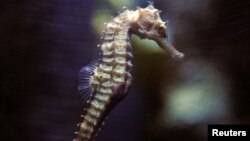- Nov 29, 2008
- 25,786
- 11,294
- 940
I came across this sweet little website and thought I'd share it. The link is her seahorse page. IMO, it is worth the visit to go there.
Wild Ocean Blue seahorses
Wild Ocean Blue seahorses
Follow along with the video below to see how to install our site as a web app on your home screen.

Note: This feature currently requires accessing the site using the built-in Safari browser.
I considered raising them for awhile but decided it would take too much time for me. Instead I just sculpt them.


Researchers said on Wednesday they sequenced the genome of a seahorse species for the first time and identified the genetic underpinning for certain peculiarities in this equine-looking fish group that inhabits coastal waters around the world. Seahorses boast a host of oddities. Males, not females, carry and give birth to babies. They swim upright, not horizontally. They have horse-like heads, tube-like snouts and no teeth. They have grasping tails to grip seagrasses and corals to avoid being swept away by currents.
Their bodies are covered in bony plates. Unlike most fish, they lack tail and pelvic fins. Their eyes work independently, letting them look forward and backward simultaneously. And they can change colors to camouflage themselves. "They are such iconic animals, one of the examples of the exuberance of evolution," said evolutionary biologist and genome researcher Axel Meyer of Germany's University of Konstanz, one of the researchers in the study published in the journal Nature. "Their numbers are declining due to habitat destruction and harvest by humans," added molecular biologist Byrappa Venkatesh of Singapore's Agency for Science, Technology and Research (A*STAR).

A seahorse swims in a tank at the Underwater World Aquarium in Pattaya, nearly 145 km (90 miles) east of Bangkok, Thailand
The researchers analyzed the genome of the Southeast Asian tiger tail seahorse, which reaches 4 inches (10 cm) long and boasts a yellow-and-black banded tail. It had the fastest rate of molecular evolution among any fish whose genome has been studied. Male seahorses possess a brood pouch. During mating, a female deposits eggs into the male's pouch. The male fertilizes the eggs internally and carries them in the pouch until they hatch, releasing the fully formed offspring into the sea. A gene present in other fish that plays a role in egg hatching underwent duplication in the seahorse and assumed a new role, helping the advent of the male pouch.
Genes that in people and other animals play a role in tooth production were mutated in seahorses and lost functionality. Lacking teeth, seahorses use their snout to suck in plankton and other tiny prey. A gene involved in development of pelvic fins in other fish and legs in humans was absent in seahorses, and they lack these fins. Instead, seahorses swim by using a small fin on their back that beats rapidly, with tiny pectoral fins placed near the back of the head used for steering.
Undersea Mystery: Seahorse Genetic Secrets Unveiled